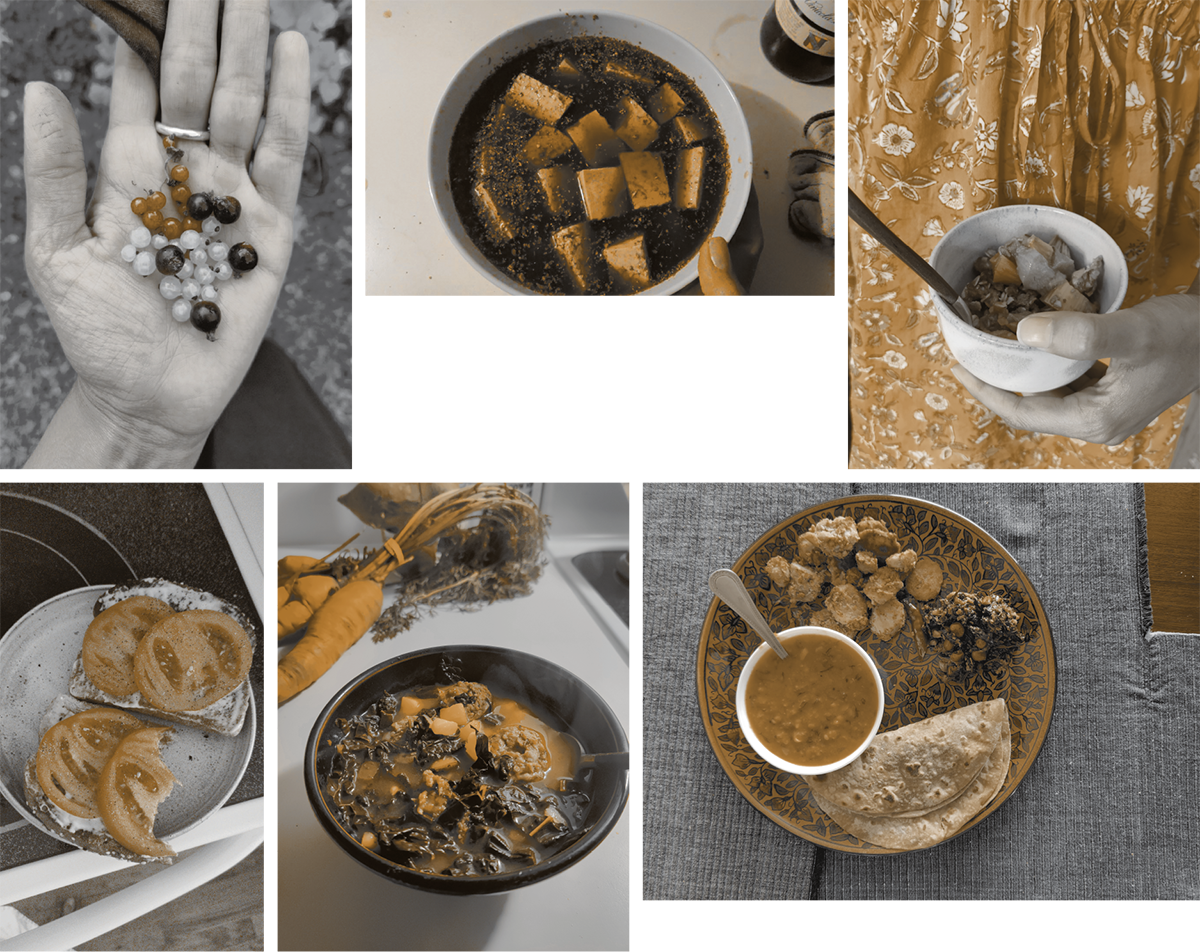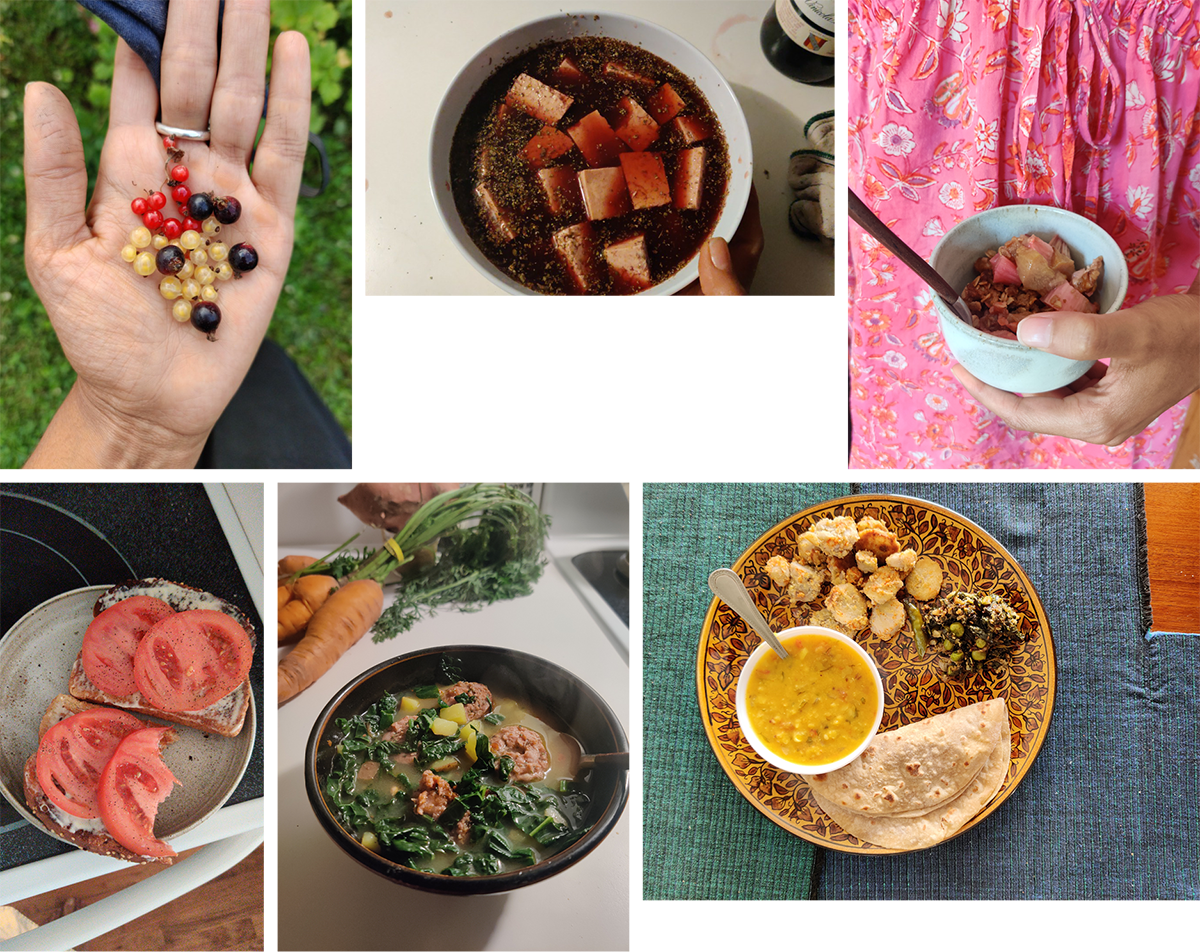Seduction Concentrate
A conversation with Ilana Harris-Babou and Pallavi Sen

Currants near the garden; tofu marinated according to a recipe in a short story; rhubarb crisp; toast with mayonnaise and tomato harvest; Alice Waters’ kale soup; dal roti with arbi and hari sabzi. Photographs by Pallavi Sen.
Ilana Harris-Babou
I wanted to talk to you, because we are collaborators. One of our biggest collaborations was being roommates during the first Covid lockdown in 2020. I learned a lot from you and your relationship with plastics and waste during that time.
We had very different experiences with plastic at home growing up. What was it like for you?
Pallavi Sen
Yeah, I grew up in the 1990s in India, when, suddenly, a lot of packaged products were coming in. We didn’t have big-box stores yet, but I remember my father describing the Container Store from his first trip to the US. We just couldn’t believe that things could come in so many colors and sizes.
He brought back two small, plastic toothpick containers: a pink one and a blue one. At the time, everything in my home was mostly handmade. There were some plastic things, like water jugs, but almost everything else was made of a natural material with a coating.
Plastic was so special; when Ruffles Lays came to India, my grandmother would wash out every bag of chips and save them underneath her oven.
IHBI grew up in an environment where plastic was about expediency. It was special, but it was also everywhere.
My mom was born in the early 1940s and is very much a mid-twentieth-century American. She was also a pediatric nurse. I remember visiting her in the hospital and seeing plastic machines, IVs, and syringes everywhere.
My family are very much New Yorkers. We had takeout for dinner almost every night, and the containers were all over the house. We’d bond by going shopping in Manhattan on the weekends and bringing back lots of branded plastic bags.
PSThe novelty and promise of bringing something new home—I have memories of that too.
I feel that there was this moment in India when our plastic use could have gone one way or another. In my childhood I saw many products becoming available in tiny sizes, all held in crimped plastic. You could buy a one-time use shampoo or a snack for not very much money. Now when you’re on the train or walking along the road, you can see small, silver rectangles of plastic everywhere.
Still, even though plastic waste is very visible in India, the same amount exists in the US. It’s hidden, because of the way it’s discarded, but just as revolting. And a curtain has been pulled away from the magic of a material, because we now understand the composition and fallout.
IHBI like making videos, because they allow me to make materials unfamiliar again.
I can take a plastic bag, put it under studio lighting, reframe it through different angles, and feel the joy of transformation. I can suspend a material in the constant flux that exists on the screen. I relish it! I can have new experiences with the stuff that’s already there.
PSI was recently watching a video you made and was reminded of how, when I was younger, I used to love playing with wet mud after the rain, because of how it felt, the squishing sounds of it, so delicious but you cannot eat it. It was lovely and chocolatey and glossy, and I think that, in your work, there’s also that same loveliness of something spreading, the temptation of something setting and then becoming shiny again.
IHBYeah, being an artist gives us an excuse to return to the same material experiments we loved as children.
PSI think about the work of artists from the early twentieth century, when there were synthetics coming in, like Annie Albers and her weavings. She worked with so many new fibers, testing how they each move, how they feel, how you can combine materials, synthetic with organic.
IHBSynthetics are just concentrated seduction! How do they do it?
PSYeah, I wonder if it’s the glossiness. There’s a gloss to the surface of stuff that doesn’t disintegrate—something that organic substances in their raw form just don’t have. And maybe it’s how light hits something that can’t break down.
The very vibrantly colorful, like something at its peak ripeness, has the same draw as plastic, and we want to move close to it. I don’t know if there’s an equivalent to it, but it’s like the molded letters on a keyboard going clack clack with the touch of acrylic nails.
Maybe a lusciousness beyond plastic is sonic! Like a conversation or song. Or it’s interaction; it’s dance; it’s a motion that makes you feel excited.
IHBOr a meal that’s about to be consumed. Or the shine in the eyes of someone you love. Right?

